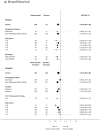How May Ramucirumab Help Improve Treatment Outcome for Patients with Gastrointestinal Cancers?
- PMID: 34298750
- PMCID: PMC8306041
- DOI: 10.3390/cancers13143536
How May Ramucirumab Help Improve Treatment Outcome for Patients with Gastrointestinal Cancers?
Abstract
GI cancers are characterized by high recurrence rates and a dismal prognosis and there is an urgent need for new therapeutic approaches. This is a narrative review designed to provide a summary of the efficacy as measured by overall survival, progression free survival, and safety data from phase 3 randomized controlled GI clinical trials of ramucirumab including those from important pre-specified patient subgroups and evidence from real clinical practice worldwide. Quality of life (QOL) is discussed where data are available. Our aim was to summarize the efficacy and safety of ramucirumab in the treatment of GI cancers using these existing published data with a view to demonstrating how ramucirumab may help improve treatment outcome for patients with GI cancers. The data indicate that ramucirumab is efficacious, safe, and tolerable across the intent-to-treat patient populations as a whole and across several pre-specified subgroups, even those whose disease is traditionally more difficult to treat. Furthermore, survival outcomes observed in real-world clinical practice demonstrate similar data from phase 3 clinical trials even in patients with complications, suggesting that the benefits of ramucirumab translate in actual clinical practice.
Keywords: angiogenesis; colorectal cancer; gastric cancer; gastrointestinal; hepatocellular carcinoma; ramucirumab.
Conflict of interest statement
Li-Tzong Chen has received grants from the Ministry of Science and Technology, Taiwan, The Ministry of Health and Welfare, Taiwan, Novartis, Pfizer, TTY, OBI, Polaris, Syncore, Merck Serono and Celgene; has received personal fees from Novartis, Eli Lilly, TTY, PharamEngine, MSD, BMS, ONO, Shire, Five Prime, Merrimack and Syncore; and has received non-financial support from Novartis, TTY, Syncore, and Celgene. Mariusz Lukanowski and Yulia D’yachkova are current employees and shareholders of Eli Lilly and Company. Rebecca Cheng was a former employee of Eli Lilly and Company and is currently a shareholder of Eli Lilly and Company. All other authors declare no conflicts of interest.
Figures






References
Publication types
LinkOut - more resources
Full Text Sources

